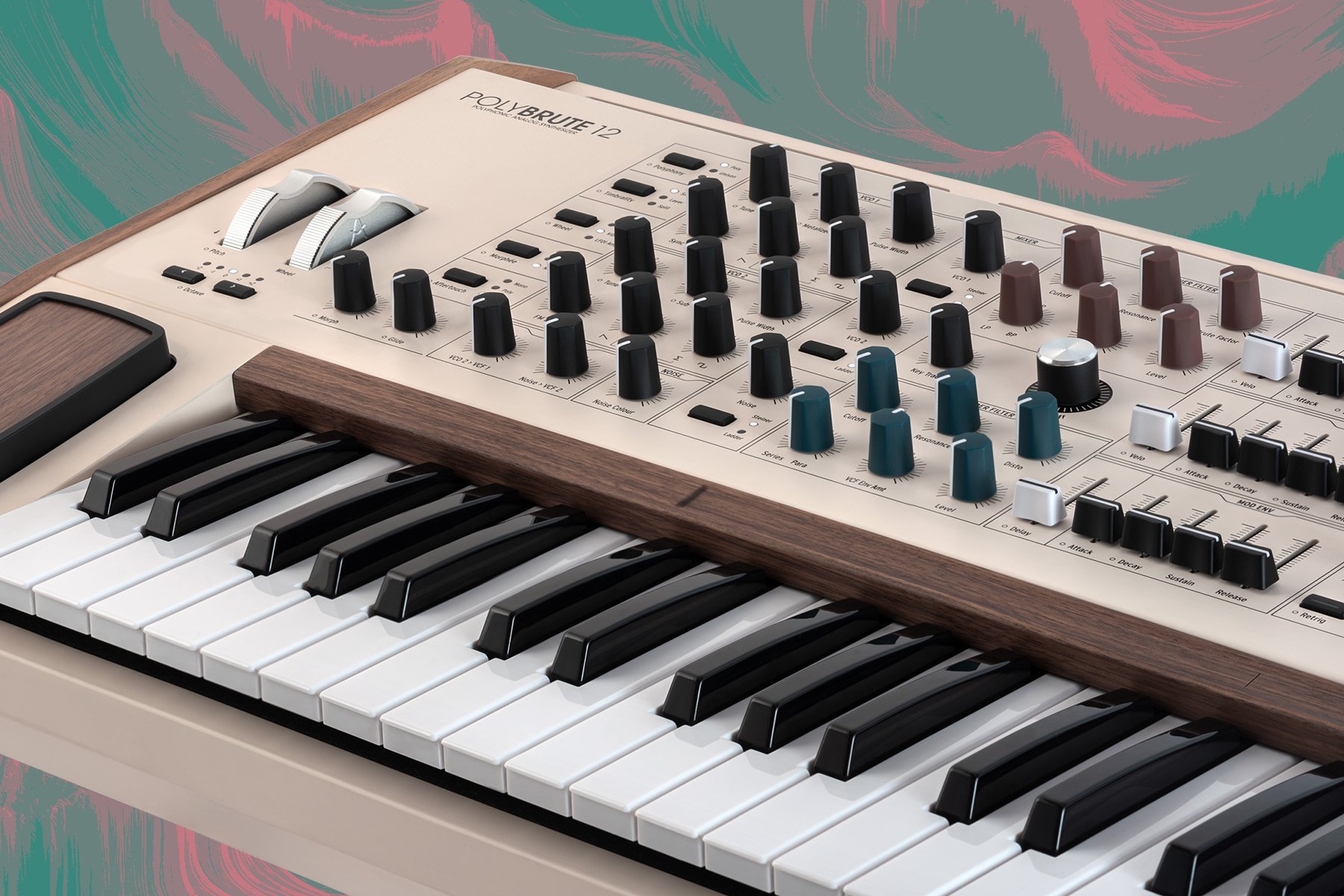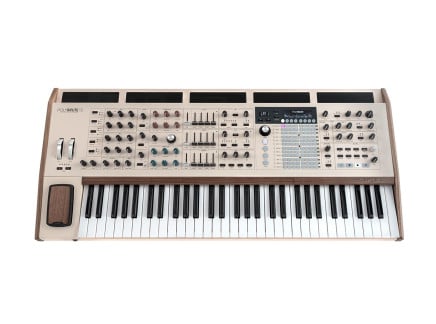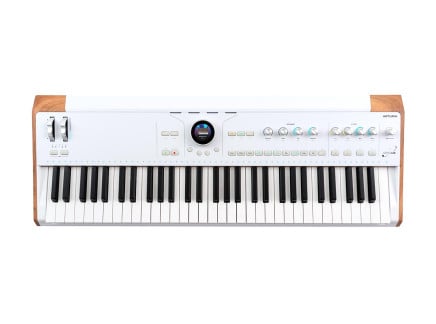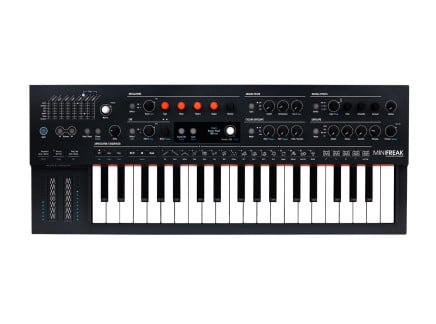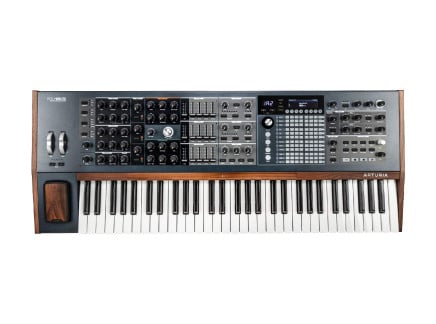Today, Arturia announces their newest synthesizer, and the newest member of the Brute family: the Polybrute 12, their most ambitious analog instrument to date. Doubling the voice count of the original Polybrute, the Polybrute 12 is an ideal tool for deep soundscapes and lush textures. All the most important features are still there: three oscillators per voice, dual filter architecture with Steiner filter and ladder filter for every voice, three envelopes, three LFOs, end-of-chain delay and reverb, and of course, the wildly deep modulation matrix.
Naturally, Polybrute's groundbreaking morphing functionality is maintained as well, allowing continuous transformation of parameter values between distinct sounds. Likewise, the Morphée 3D touch controller and ribbon controller are intact, both providing ample opportunity for expressive playing. But...Polybrute 12 has some new tricks up its sleeve, as well.
Polybrute 12 is the first instrument to use Arturia's new FullTouch keyboard technology, allowing new levels of expression and control not possible on traditional synthesizer keybeds. While the name "FullTouch" might seem to imply that they've simply implemented a poly-aftertouch-capable keyboard, that doesn't quite cover all the potential uses. Indeed, FullTouch represents a surprising and quite interesting update to standard synthesizer keyboard technology—allowing for several layers of polyphonic expression. Combined with the extensive modulation possibilities provided by Polybrute's modulation matrix, this opens up the potential for everything from Vangelis-style swells to entirely new types of sonic exploration and experimentation.
Because Polybrute 12 so closely resembles its sibling, the Polybrute, I won't go deep into describing its sonic architecture in this article; suffice it to say that if you want a rich-sounding polyphonic analog synthesizer with an enormous range of options for developing evolving and responsive sounds, you will be well-served by either. Indeed, we believe that these are two of the most interesting and sophisticated polyphonic analog synthesizers ever developed. Instead of focusing on its sound engine alone, though, I'd like to dedicate this article to a closer look at what Arturia's FullTouch technology actually means for you—as for many performers and composers, I expect it will be a welcome addition.
So What's So Special About FullTouch?
The last several years, we've seen a (quite welcome) resurgence of polyphonic aftertouch as a control method on commercial electronic musical instruments. All but abandoned since the 1980s heyday of synthesizers, polyphonic aftertouch is a famously significant feature of such classic instruments as the Yamaha CS-80, Sequential Circuits Prophet T8, and the New England Digital Synclavier II—forming a significant part of these instruments' characteristic sound. However, from the '90s to the 2010s, it became increasingly rare to see polyphonic aftertouch as a possibility in new instruments, despite its expressive potential.
Its re-arrival came in several stages: from the development of early MPE (MIDI Polyphonic Expression) controllers, the introduction of the ASM Hydrasynth (with its own proprietary approach called Polytouch), and the introduction of a Fatar polyAT-capable keybed have all signaled that interest in polyphonic aftertouch technologies has been growing. Now a staple part of instruments from ASM, Waldorf, and others, we expect that exploration of traditional polyphonic aftertouch will continue.
Arturia's FullTouch keyboard represents a big step forward—they are a large company demonstrating interest in pushing expressive gestural detection to new depths, and indeed, we haven't seen an approach quite like the Polybrute 12 keyboard in any instrument aside from the boutique Osmose, developed by small French company Expressive E. So, what is Full Touch, and how does it differ from conventional polyphonic aftertouch?
Let's start by talking about how synthesizer keyboards usually work. Let's think of an individual key on a synthesizer as being, essentially, a type of switch with two states: on and off. Most synthesizers can, through fairly simple methods, detect the speed at which the switch is engaged (a parameter which we commonly call velocity)—but aside from that, the key really only produces two distinct detectable states: on, and off. On most synth action keyboards, the key is only considered to be "on" once it has been depressed a fairly significant amount: it takes quite a bit of travel downward before the synthesizer engine will acknowledge that you are, in fact, pressing a key.
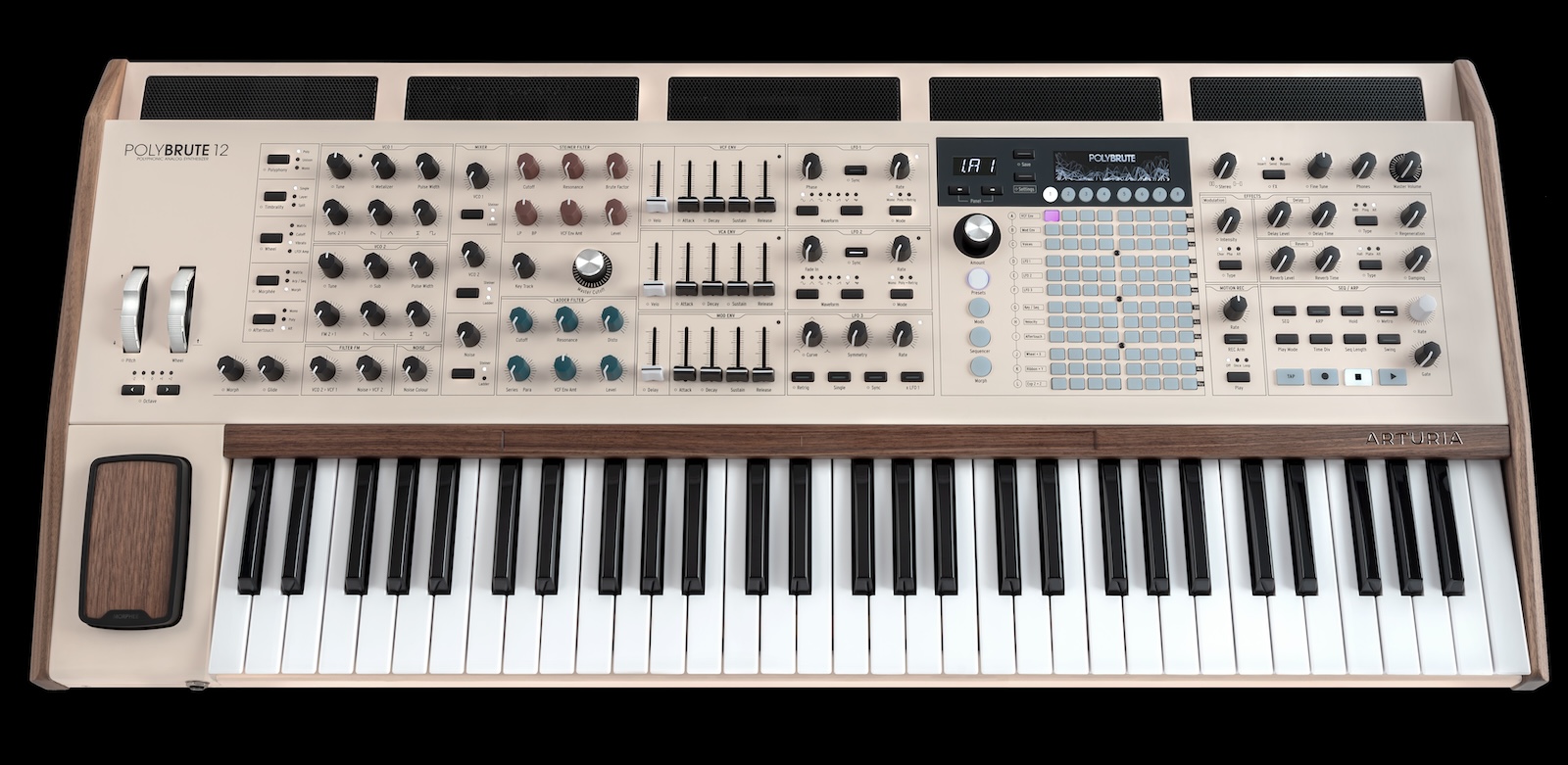
Traditional aftertouch is based on detecting the amount of pressure applied to a key after that specific threshold has been breached. Essentially, you've already pressed the key, and it is physically in the lowest position it can possibly reach. By applying additional pressure, an extra sensor can transmit data about how hard you are pressing: this is how aftertouch is defined. In an instrument with polyphonic aftertouch, this type of data can be detected from multiple keys simultaneously, and can be used independently to affect specified parameters of the voice(s) that the key presses each instantiated. This allows, of course, independent expressive control for each note that you're playing: you could use individual, per-finger pressure to sweep the filters of each voice independently, to speed up LFOs, and so on.
The thing is, aftertouch only works once the key is fully depressed. But...what if the entire travel of the key could be detected? What if the continuous displacement of the key could suddenly be leveraged as its own expressive control source independently from traditional aftertouch?
That is the key question that Arturia's FullTouch keyboard sensing method seeks to answer. Indeed, this keyboard can detect continuous vertical displacement, and gives you access to its full range of pressure sensing in a variety of ways. Specifically, there are four specific types of sensing available on Polybrute 12:
- 1: Monophonic aftertouch
- 2: Polyphonic aftertouch
- 3: FullTouch AT
- 4: FullTouch AT>Z
- 5: FullTouch Env>AT
The first two modes are simple enough: they provide typical synth action response, with monophonic or polyphonic aftertouch. These should provide a familiar playing response, and should translate perfectly well to the types of patches you might make on other keyboards that leverage these types of expressive control. But, FullTouch is where things really start to open up and offer new possibilities.
Let's start by talking about FullTouch AT mode. In this mode, there are two key differences from typical synth action and conventional aftertouch. First of all, the note is triggered at the very top of the key rather than needing to press the key fully for a note to be triggered. Even a very slight touch is enough to trigger a note. Second, the aftertouch response kicks in immediately, and utilizes the full range of the key. That is to say, aftertouch starts to take effect immediately, rather than requiring you press the key completely and then press even harder for the aftertouch to be activated. On a technical level, this is somewhat comparable in capability to typical aftertouch, however the key points in the physical travel of the key—that is, the point at which a note is triggered, and the point at which aftertouch becomes accessible—are located at different points along the travel of the key, and occupy the full range of the key's vertical travel. So, while on paper you might think of this as being similar to traditional synth action, the feeling is quite different; and no doubt, it will inspire completely different playing styles and sonic possibilities as a result.
FullTouch AT>Z goes a step further. It works similarly to the FullTouch AT mode we've just described; however, as the key travels downward, you'll feel a second "layer" of aftertouch start to kick in. Indeed, there is a point at which you will feel haptic response from an internal spring mechanism. The travel of the key before this point is used to define aftertouch values in the modulation matrix; the travel of the key beyond this point is used to define a separate polyphonic modulation source called Z in the matrix. Notes are still triggered at the very top of the key, allowing for the same delicate sorts of playing styles found in FullTouch AT mode. This means that you can effectively have two "layers" of pressure-based modulation: once the first layer of aftertouch has reached its maximum, you can press further into the key to activate additional modulation. The physical sensation of transitioning from one layer to the next is quite obvious, and yet still smooth and continuous. With clever matrix mappings, you can get to a huge range of quite nuanced sounds in this way.
The final mode, FullTouch Env>AT uses the keyboard's detailed position sensing in order to detect a variety of aspects of how you're interacting with the keyboard. In essence, rather than keys simply triggering the synth voices' envelopes, you instead can use your interactions with the keys to define, in real time, how the envelopes respond. By detecting the keys' instantaneous position and deriving a sense of velocity by assessing their change in position over time, the keyboard can be used to effectively define envelope shapes intuitively and expressively. This is a bit difficult to explain—however, the basic idea is that the envelopes suddenly will respond to even very fine details in your playing, creating sounds that, for a synthesizer, are uncommonly responsive, nuanced, and natural-sounding.
New sensing types aside, the custom keybed in Polybrute 12 differs from most synth keybeds in a variety of ways: the keys don't exhibit lateral "wiggle"; additionally, they're much longer than usual synthesizer keys (i.e., they extend further into the body of the instrument). This results in a somewhat more sturdy and piano-like feel—truly, a more high-end, rugged feeling than most typical synth action keyboards. It is capable of transmitting MPE data, and as such, can act as an excellent controller for external software, sound modules, etc.
And of course, let's not forget that Polybrute 12 is also just an excellent-sounding synthesizer. It would be well worth the investment even with a standard keyboard; however, the new possibilities presented by Arturia's FullTouch technology will no doubt help to find new levels of nuance in an already great-sounding, well-thought-out sound engine. So, if you're just looking for a polyphonic analog synthesizer, it immediately comes highly recommended. If you're also looking for a new, intuitive, and surprisingly immediate way of engaging musically with an electronic instrument, it will likely prove to be exactly what you're looking for.

